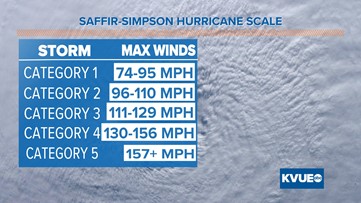- Artists transform hurricane aftermath into hoop-inspired masterpieces at Charlotte exhibit
- NC's cost for Hurricane Helene damage is nearly $60 billion, state says
- State to develop drone program to better respond to disasters like Helene, Florence
- South Carolina residents face deadline to get storm debris out to the curb after Hurricane Helene
- SCDOT to pick up Hurricane Helene debris for a final day in South Carolina
Do we need a Category 6 for hurricanes? A new study proposes an extra category

The climate study found five storms in recent history that would have been a hypothetical Category 6.
AUSTIN, Texas — Researchers are proposing that our scale for measuring hurricanes is not good enough.
In a new study, the Proceedings of the National Academy of Sciences, say we need a Category 6. They explain that this proposed extra category is mainly due to the effects climate change has had, and will have, on tropical storms in the next 30 to 40 years.
The reason is that studies show warmer air and sea surface temperatures can increase the amount of precipitation dropped by tropical storms, as well as set the stage for faster rapid intensification.
The Saffir-Simpson scale was created by the National Hurricane Center in the 1970s. It labels hurricane strength from Category 1 through Category 5, with a range of speeds that coincide with each category.
Overall, the changes in the PNAS scale would be minor. Every category stays the same, except Category 5 winds would be capped at 192 mph, and Category 6 winds would be anything greater than 192 mph.

In the past nine years of records, PNAS says five storms have reached their hypothetical Category 6. However, four out of the five were typhoons in the western Pacific. Hurricane Patrica occurred in the eastern Pacific in 2015, making landfall as a Category 4 in Jalisco, Mexico. Patricia’s maximum sustained winds went up to 215 mph, which is the highest wind speed recorded of any hurricane or typhoon on Earth.
The PNAS thinks that adding another category will make labeling hurricane strength more accurate. Setting apart super-strong storms in a way that the current scale can not.
On the other hand, PNAS acknowledges that adding another category will not change some of the existing issues of the Saffir-Simpson scale.
“Detailed sociological research would be in order before making any changes to current messaging. In particular, perceptions about climate change may complicate the effectiveness of additional hurricane categories” PNAS stated.
The scale is only based on wind speeds, while there are many other risks and implications at play when forecasting tropical storms and hurricanes. Neither the existing nor proposed scale, mentions the added risks for flooding and storm surge that often accompanies tropical storms.